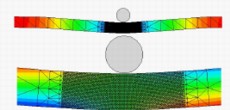Home > Press > "Michigan Nano Computational Cluster” (MNC2)
 |
Abstract:
The National Nanotechnology Infrastructure Network's computational project (NNIN/C) is a multi-university initiative, funded by the National Science Foundation (NSF) as part of NNIN, to establish a user accessible national computing resource for nanotechnology. This network is open to the academic and industrial research community and provides hardware resources and simulation tools dedicated to nanoscience research. Strong technical and scientific support is provided by staff experts so that the tools and resources can benefit interdisciplinary research. The software tools include commercial software packages for design, characterization and analysis of nanometer scale devices as well as some of the latest academic advances in nanoscale modeling and simulation software.
"Michigan Nano Computational Cluster” (MNC2)
Posted on August 8th, 2012The NNIN computational facility at Michigan is located in the Electrical Engineering and Computer Engineering (EECS) Building.
Among the goals and strategies of NNIN/C are:
- Assemble and create a wide suite of robust software that addresses critical issues in the molecular and electronic structure and physical and chemical dynamics of artificial and natural nanoscale structures.
- Maintain and, where necessary, modify these simulations to address a widening scope of research problems.
- Provide strong technical support and thorough instruction on the software tools so as to permit even novice users to progress rapidly to the solutions of their own unique research problems.
- Provide web-based graphical user interfaces (GUIs) for user-friendly access to simulation tools as well as web-based resources for instruction and feedback to the community of researchers employing the same tools.
Critical to the NNIN/C effort is the high level staff support offered at each participating site. Dr. Behrouz Shiari is the computation expert for the NNIN/C at Michigan. Dr. Shiari is not only proficient in most software packages, he can also assist in the development of new simulation tools for clients' specific needs.
NNIN/C has a growing base of users based on our current hardware facilities and a suite of programs which form the backbone of the project. NNIN/C comprises a broad community that includes both users and contributors, including:
- Experimentalists fabricating and measuring nanoscale devices for which numerical simulations can optimize the output either by shortcutting device design or analyzing results of measurements
- Theorists and computational scientists seeking to employ state-of-the-art simulations in nanoscience but lacking access either to the hardware or software, or more crucially, lacking the information on how to obtain or use such software packages
- Researchers interested in particular materials or device configurations for which currently available simulation tools do not exist or need to be extended
- Computational nanoscientists with a specific research code that they wish to make more broadly available to the nanotechnology community. NNIN can assist in making the code more robust and user friendly, and host it so that it can be used by a broader community.
The "Michigan Nano Computational Cluster" (MNC2) consists of 14 nodes. Each compute node contains a hexa-core Intel Xeon X5660 processor running at 2.66 GHz, 24 GB of memory. MNC2 contains 168 processing cores linked with Gigabit ethernet, 12 TB of disk space.
MNC2 currently hosts simulation tools for micro/nanoscale systems including codes for first principles calculation, photonic devices, molecular dynamics, multiphysics, and multiscale.
####
For more information, please click here
Contacts:
Parameshwaran Pasupathy
Dr Behrouz Shiari
Copyright © http://lnf.umich.edu/nnin-at-michigan/
If you have a comment, please Contact us.Issuers of news releases, not 7th Wave, Inc. or Nanotechnology Now, are solely responsible for the accuracy of the content.
| Related News Press |
News and information
![]() Researchers develop molecular qubits that communicate at telecom frequencies October 3rd, 2025
Researchers develop molecular qubits that communicate at telecom frequencies October 3rd, 2025
![]() Next-generation quantum communication October 3rd, 2025
Next-generation quantum communication October 3rd, 2025
![]() "Nanoreactor" cage uses visible light for catalytic and ultra-selective cross-cycloadditions October 3rd, 2025
"Nanoreactor" cage uses visible light for catalytic and ultra-selective cross-cycloadditions October 3rd, 2025
Hardware
![]() The present and future of computing get a boost from new research July 21st, 2023
The present and future of computing get a boost from new research July 21st, 2023
![]() A Carbon Nanotube Microprocessor Mature Enough to Say Hello: Three new breakthroughs make commercial nanotube processors possible March 2nd, 2020
A Carbon Nanotube Microprocessor Mature Enough to Say Hello: Three new breakthroughs make commercial nanotube processors possible March 2nd, 2020
![]() Powering the future: Smallest all-digital circuit opens doors to 5 nm next-gen semiconductor February 11th, 2020
Powering the future: Smallest all-digital circuit opens doors to 5 nm next-gen semiconductor February 11th, 2020
Academic/Education
![]() Rice University launches Rice Synthetic Biology Institute to improve lives January 12th, 2024
Rice University launches Rice Synthetic Biology Institute to improve lives January 12th, 2024
![]() Multi-institution, $4.6 million NSF grant to fund nanotechnology training September 9th, 2022
Multi-institution, $4.6 million NSF grant to fund nanotechnology training September 9th, 2022
Announcements
![]() Rice membrane extracts lithium from brines with greater speed, less waste October 3rd, 2025
Rice membrane extracts lithium from brines with greater speed, less waste October 3rd, 2025
![]() Researchers develop molecular qubits that communicate at telecom frequencies October 3rd, 2025
Researchers develop molecular qubits that communicate at telecom frequencies October 3rd, 2025
![]() Next-generation quantum communication October 3rd, 2025
Next-generation quantum communication October 3rd, 2025
![]() "Nanoreactor" cage uses visible light for catalytic and ultra-selective cross-cycloadditions October 3rd, 2025
"Nanoreactor" cage uses visible light for catalytic and ultra-selective cross-cycloadditions October 3rd, 2025
|
|
||
|
|
||
| The latest news from around the world, FREE | ||
|
|
||
|
|
||
| Premium Products | ||
|
|
||
|
Only the news you want to read!
Learn More |
||
|
|
||
|
Full-service, expert consulting
Learn More |
||
|
|
||








